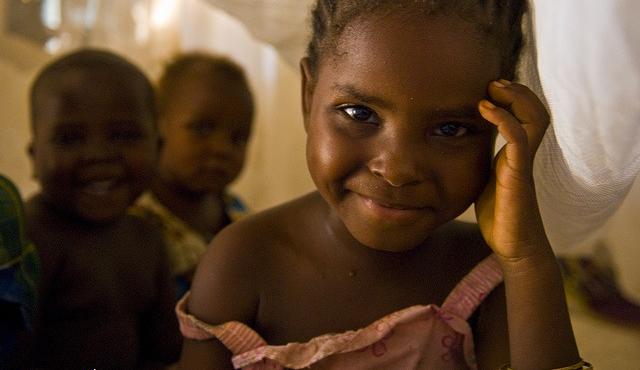By Magdalena Janus, Professor of Psychiatry and Behavioural Neurosciences (McMaster University), Offord Centre for Child Studies

The recent edition of the SDG 4 Data Digest illustrates the range of partners working alongside the UNESCO Institute for Statistics (UIS) to help countries produce and use assessment data to strengthen lifelong learning. This blog highlights one of these vital partners: the Offord Centre for Child Studies, and specifically Professor Magdalena Janus, who brought years of expertise to the Digest’s analysis on early childhood development (ECD). Here, Magdalena shares her thoughts on the critical importance of measuring early learning.
At the launch of the 2018 SDG 4 Data Digest in December, Silvia Montoya, Director of the UNESCO Institute for Statistics (UIS), said: “We learn to walk, to talk, to think. We learn how to live together. We learn the working skills needed to make a living and to contribute to society. In other words, we learn how to learn.”
That learning starts in the earliest years of childhood and it provides the building blocks for all the learning that is to follow. In the SDG 4 Data Digest, I argue that learning is a combination of cognitive and social processes shaped by cultural practices, customary behaviours and social interactions.
Despite a wide range of impact these different forces may have on global measures of learning, there are universalities that need to be found and then complemented with culturally-sensitive metrics. Understanding early childhood learning is challenging, but it is vital if we are to generate comparable data and support equitable education.
The challenges also start early. The youngest children in the poorest households and in conflict zones are the least likely to have access to education, just as their developing brains are most receptive to the information that paves the way for lifelong learning. Even temporary exposure to risky environments can disrupt the process of development and have lasting consequences.
That is why SDG 4 Target 4.2 aims to ensure that, by 2030: all girls and boys have access to quality early childhood development, care and pre-primary education so that they are ready for primary education. Indicator 4.2.1 for this crucial target measures “the proportion of children under 5 years of age who are developmentally on track in health, learning and psychosocial wellbeing, by sex”.
Thus, the inclusion of early childhood education in the SDGs reflects the importance of early development, not only for the well-being of individuals but also for the well-being of entire nations.
The opportunities
It is not easy to get the full picture of a child’s status when describing it via a number. We have to add character and depth to indicators by putting data to work, to visualise and interpret trajectories of learning as we develop innovative strategies to address the knowledge gap in very early development.
Target 4.2 gives us the opportunity to broaden our scope, requiring us to provide reliable tools and methodologies to learn about common trends and factors, including cross-national, ethnic, geographic and (dis)ability boundaries, while developing best practices, optimal outcomes and customised approaches.
Very often we can make better use of what we already have through the innovative use of existing, historical data; creating platforms for data-sharing and storage; developing techniques for data harmonisation; and by expanding, rather than replacing, support for locally-relevant data collection. While our aim should be one common way to measure Target 4.2 worldwide, its interpretation cannot be confined to one single number devoid of context.
The challenges
While the opportunities are beguiling, the challenges are daunting. There are three, in particular. First, the use of one measurement as the only way to monitor learning and development is unrealistic and unnecessary. Second, there are many inherent sources of error in measurement – the most obvious being the way in which assessments are administered, which varies by the age groups covered and the intended purpose. And third, how can we ensure that most or all countries report on one – let alone more than one – type of measurement?
Remember, we are talking about very young children here. If we measure their learning by interviewing their caregiver, are we really hearing the child? If we conduct direct assessments, do we have a pool of assessors who are skilled in interviewing young children? Each of these methods provides a picture of child development that complements the other; neither is perfect, neither is bad.
In fact, recent analysis of data for children under three years old from a variety of countries, collected with various instruments (some locally-developed), found a remarkably stable and comparable normative curve of the child development trajectory, regardless of the country or data tool. So it is possible!
A broad vision
The vision for the new set of measures must be broad. For example, UNICEF’s revised Early Childhood Development Index (ECDI) aims for a short, globally-comparable and easy-to-interpret metric and should become part of as many local measurement and evaluation initiatives as possible. Data are already available for more than 50 low- and middle-income countries, with the ECDI embedded in UNICEF’s Multiple Indicator Cluster Survey (MICS), the largest source of statistically-sound and internationally-comparable data on women and children worldwide.
The Early Development Instrument (EDI) has been successful in monitoring child development in several countries, including Australia, Brazil, Canada, Jordan and Kyrgyzstan, and its use over time could enhance our understanding of trends at the regional level. There are also many databases of information on the developmental status of young children that could be harnessed to provide a baseline for further monitoring of progress towards Target 4.2. New initiatives, such as the Measuring Early Learning Quality and Outcomes project (MELQO) and the Global Scale for Early Development Group (GSED), are emerging.
Next steps
I see three actions for the international community. First, the promotion of a short, feasible and ‘universal’ assessment. Second, facilitating the continuous use of validated tools that address more comprehensive development from a variety of perspectives, in a way that is culturally- and disability-sensitive rather than neutral. And third, enabling the collection of contextual, socioeconomic, demographic, educational and health service data that supports the interpretation of Indicator 4.2.1.
As the UIS Digest stresses, effective monitoring requires human capacity that can interpret key variations across groups of interests, such as countries or regions. That requires a broader perspective on several fronts: coverage (inclusive of children with disabilities), mode and ease of administration, cultural applicability and local relevance and, importantly, national preferences.
The aim should never be to create league tables. Rather, it should be to understand and act on the progress (or lack of it) of young children that may be shaped by very different contexts in different parts of our world.
About the Author

Leave a comment